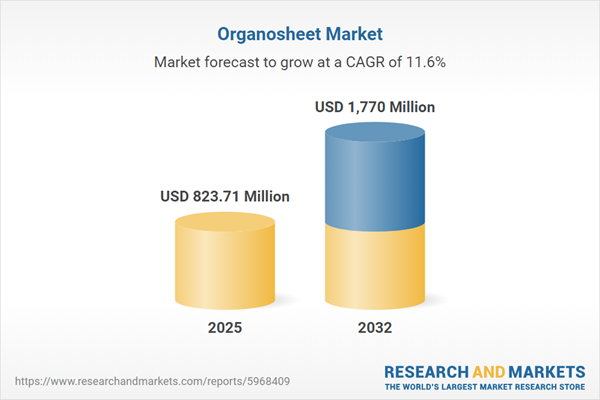Speak directly to the analyst to clarify any post sales queries you may have.
The organosheet market is rapidly evolving as a critical force in transforming packaging, agriculture, medical, and industrial applications worldwide. Senior leaders increasingly recognize its strategic importance, as advanced composites address performance, regulatory, and sustainability demands across the value chain.
Market Snapshot: Organosheet Market Size and Growth Outlook
The organosheet market grew from USD 736.98 million in 2024 to USD 823.71 million in 2025. It is expected to continue growing at a CAGR of 11.62%, reaching USD 1.77 billion by 2032. Key factors driving this robust expansion include increasing demand for lightweight, high-strength alternatives in end-use industries, evolving regulatory landscapes, and the push for sustainable material solutions.
Scope & Segmentation: Comprehensive Overview of the Organosheet Market
This report provides an in-depth assessment of the organosheet sector, exploring primary growth segments, application areas, and material advancements aligned with shifting industry needs.
- Product Types: Agricultural films (including greenhouse, mulch, and silage films), food packaging (flexible and rigid formats), industrial packaging (pallet wrap and stretch film), and medical packaging (non-sterile and sterile categories).
- Application Sectors: Agriculture (greenhouse coverings, mulch, pond liners), construction (damp proof membranes, insulation backings), medical (devices, sterile packaging), and broad packaging for food, industrial, and pharmaceutical uses.
- Material Types: Polyethylene (high- and low-density), polyethylene terephthalate (PET, PETG), and polyvinyl chloride (flexible and rigid variants).
- Geographic Regions: Americas (with detail on North America and Latin America), Europe Middle East Africa (EMEA—including Western and Eastern Europe, Middle East, Africa), and Asia-Pacific (notably China, India, Southeast Asia, Japan, and leading clusters).
- Key Companies: Teijin Limited, Toray Industries Inc., SGL Carbon SE, Mitsubishi Chemical Corporation, Hexcel Corporation, Solvay S.A., BASF SE, Huntsman Corporation, Owens Corning Inc., Zhongfu Shenying Carbon Fiber Co., Ltd.
Key Takeaways: Strategic Insights for Decision-Makers
- Organosheets have evolved from traditional laminates into adaptable, multipurpose composites meeting strict functional and sustainability standards for industrial, packaging, and medical markets.
- Material innovation—such as bio-based thermoplastics and mechanically robust resins—enables features like antimicrobial surfaces, flame-retardancy, and enhanced barrier properties tailored to diverse sector demands.
- Regulatory requirements push manufacturers toward recyclable formulations and closed-loop processes, with compliance agility and eco-efficient production emerging as priorities for market participants.
- Supply chain agility is crucial, with leaders adopting nearshoring, dual-sourcing, and localized compounding to manage disruptions resulting from market volatility and trade regulations.
- Partnership models are shifting, as resin producers, converters, and end-users collaborate to accelerate product iteration and streamline R&D outcomes.
- Regional growth patterns are shaped by local initiatives—such as agricultural modernization in the Americas, circular-economy mandates in EMEA, and rapid infrastructure development in Asia-Pacific—making flexible strategy essential for accessing high-potential corridors.
Tariff Impact: Navigating Trade Disruptions and Margin Pressures
New US tariff measures in 2025 add complexity to global supply chains for organosheet raw materials and components. This prompts industry players to review supplier portfolios and consider sourcing adjustments. Companies responsive to tariff-induced cost pressures leverage in-house production or regionalize operations to retain their competitive position, while others face higher procurement costs and shifting product design requirements.
Methodology & Data Sources: Rigor and Relevance
This analysis is rooted in primary interviews with industry specialists—materials scientists, converters, procurement managers, and regulatory experts—combined with secondary literature from industry journals and trade association reports. Triangulation with trade statistics and patent analysis ensures reliable, multidimensional findings that support confident decision-making.
Why This Report Matters: Actionable Intelligence for Senior Leaders
- Empowers executives to anticipate regulatory, material, and trade-driven disruption, enabling agile risk mitigation strategies.
- Delivers granular segmentation and regional insights, supporting resource allocation and market entry plans with confidence and clarity.
- Supports the development of innovative product pipelines and sustainable operations, essential for achieving long-term growth in industrial environments.
Conclusion: Strategic Direction in a Dynamic Market
This report equips decision-makers with comprehensive market intelligence to identify opportunities and proactively address evolving industry complexities. Leveraging these insights will enhance competitiveness, operational resilience, and long-term market position as the organosheet landscape continues to evolve.
Additional Product Information:
- Purchase of this report includes 1 year online access with quarterly updates.
- This report can be updated on request. Please contact our Customer Experience team using the Ask a Question widget on our website.
Table of Contents
3. Executive Summary
4. Market Overview
7. Cumulative Impact of Artificial Intelligence 2025
Companies Mentioned
The companies profiled in this Organosheet market report include:- Teijin Limited
- Toray Industries, Inc.
- SGL Carbon SE
- Mitsubishi Chemical Corporation
- Hexcel Corporation
- Solvay S.A.
- BASF SE
- Huntsman Corporation
- Owens Corning Inc.
- Zhongfu Shenying Carbon Fiber Co., Ltd.
Table Information
| Report Attribute | Details |
|---|---|
| No. of Pages | 198 |
| Published | October 2025 |
| Forecast Period | 2025 - 2032 |
| Estimated Market Value ( USD | $ 823.71 Million |
| Forecasted Market Value ( USD | $ 1770 Million |
| Compound Annual Growth Rate | 11.6% |
| Regions Covered | Global |
| No. of Companies Mentioned | 11 |









